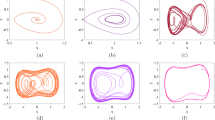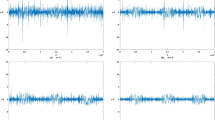Abstract
The popularly known integer-order chaotic oscillators are widely used to detect ship-radiated noise (S-RN). However, the current integer-order oscillators exhibit low accuracy in detecting complex S-RN. In this study, a method is proposed to detect ship-radiated noise based on double complexity and fractional-order dual coupling Duffing system to address the challenge. Firstly, embedding the integer derivative, we put forward a fractional-order dual coupling Duffing oscillator, a novel chaotic oscillator that considers the derivative changes. Secondly, determining the critical threshold of the system is to combine a double complexity algorithm with phase trajectory observation. The double complexity algorithm is utilized to determine the critical threshold and reduce the error in phase trajectory observation. Then, studying the dynamic behavior of the fractional-order dual coupling Duffing system, we demonstrate that the critical threshold of the fractional-order system is lower than the integer-order system and changes more drastically near the critical threshold. Finally, measured and analog signals are used to verify the performance of the proposed detection method. We empirically show that the method has a fine detection performance. Analyzing the system performance under the same detection signal and noise distribution, the signal-to-noise ratio threshold of the proposed detection method is −43.01 dB. This research generalizes the Duffing oscillator, aiming to explore the practical application of the fractional chaotic system.

































Similar content being viewed by others
Data availability
Some or all data, models, or code generated or used during the study are available from the corresponding author by request.
References
Yang, H., Shi, W.S., Li, G.H.: Underwater acoustic signal denoising model based on secondary variational mode decomposition. Def Technol 28, 87–110 (2023). https://doi.org/10.1016/j.dt.2022.10.011
Yang, H., Yang, X.D., Li, G.H.: Dual feature extraction system for ship-radiated noise and its application extension. Ocean Eng. 285, 115352 (2023). https://doi.org/10.1016/j.oceaneng.2023.115352
Li, J.H., Zakharov, Y.V., Henson, B.: Multibranch autocorrelation method for Doppler estimation in underwater acoustic channels. IEEE J. Oceanic Eng. 43(4), 1099–1113 (2018). https://doi.org/10.1109/JOE.2017.2761478
Huang, S.H., Tsao, J., Yang, T.C., Cheng, S.W.: Model-based signal subspace channel tracking for correlated underwater acoustic communication channels. IEEE J. Oceanic Eng. 39(2), 343–356 (2014). https://doi.org/10.1109/JOE.2013.2251808
Zhao, J.H., Yan, J., Zhang, H.M., Meng, J.X.: Two self-adaptive methods of improving multibeam backscatter image quality by removing angular response effect. J. Mar. Sci. Technol. 22(2), 288–200 (2017). https://doi.org/10.1007/s00773-016-0410-1
Sun, J.P., Yang, J., Lin, J.H., Jiang, G.J., Yi, X.J., Jiang, P.F.: Theoretical model and simulation of ship underwater radiated noise. Acta Physica Sinica. 65(12), 124301 (2016). https://doi.org/10.7498/aps.65.124301
Wu, G.L., Dong, H.F., Ke, G.P., Song, J.Q.: An adapted eigenvalue-based filter for ocean ambient noise processing. Geophysics 85(1), KS29–KS38 (2020). https://doi.org/10.1190/geo2018-0861.1
MacGillivray, A., de Jong, C.: A reference spectrum model for estimating source levels of marine shipping based on automated identification system data. J. Mar. Sci. Eng. 9(4), 369 (2021). https://doi.org/10.3390/jmse9040369
Yan, J.Q., Sun, H.X., Chen, H.L., Junejo, N.U.R., Cheng, E.: Resonance-based time-frequency manifold for feature extraction of ship-radiated noise. Sensors 18(4), 936 (2018). https://doi.org/10.3390/s18040936
Yang, H., Li, L.L., Li, G.H.: A new denoising method for underwater acoustic signal. IEEE Access 8, 201874–201888 (2020). https://doi.org/10.1109/ACCESS.2020.3035403
Li, G.H., Yang, Z.C., Yang, H.: A denoising method of ship radiated noise signal based on modified CEEMDAN, dispersion entropy, and interval thresholding. Electronics 8(6), 597 (2019). https://doi.org/10.3390/electronics8060597
Li, G.H., Bu, W.J., Yang, H.: Research on noise reduction method for ship radiate noise based on secondary decomposition. Ocean Eng. 268, 113412 (2023). https://doi.org/10.1016/j.oceaneng.2022.113412
Kim, Y., Park, S.G.: On the second order effect of the springing response of large blunt ship. Int. J. Naval Archit. Ocean Eng. 7(5), 873–887 (2015). https://doi.org/10.1515/ijnaoe-2015-0061
Xiao, Q., Zhao, W.J., Zhu, R.C.: Effects of wave-field nonlinearity on motions of ship advancing in irregular waves using HOS method. Ocean Eng. 199, 106947 (2020). https://doi.org/10.1016/j.oceaneng.2020.106947
Zhang, J.W., Hou, G., Wang, H., Zhao, Y., Huang, J.L.: Operation feature extraction of flood discharge structure based on improved variational mode decomposition and variance dedication rate. J. Vib. Control 26(3–4), 229–240 (2019). https://doi.org/10.1177/1077546319878542
Dong, H.T., Wang, H.Y., Shen, X.H., Jiang, Z.: Effects of second-order matched stochastic resonance for weak signal detection. IEEE Access. 6, 46505–46515 (2018). https://doi.org/10.1109/ACCESS.2018.2866170
Dong, H.T., Wang, H.Y., Shen, X.H., He, K.: Parameter matched stochastic resonance with damping for passive sonar detection. J. Sound Vib. 458, 479–496 (2019). https://doi.org/10.1016/j.jsv.2019.06.021
Li, Z., Lian, X.Y.: The application of chaos theory in the ship radiated noise feature extraction. Ship Sci. Technol. 39(20), 28–30 (2017)
Huang, S.H., Hou, X.G., Liu, W.W., Liu, G.J., Dai, Y.W., Tian, W.: Mimicking ship-radiated noise with chaos signal for covert underwater acoustic communication. IEEE Access 8, 180341–180351 (2020). https://doi.org/10.1109/ACCESS.2020.3027022
Yang, H., Li, L.L., Li, G.H., Guan, Q.R.: A novel feature extraction method for ship-radiated noise. Def. Technol. 18(4), 604–617 (2022). https://doi.org/10.1016/j.dt.2021.03.012
Liu, F., Li, G.H., Yang, H.: A new feature extraction method of ship radiated noise based on variational mode decomposition, weighted fluctuation-based dispersion entropy and relevance vector machine. Ocean Eng. 266(5), 113143 (2022). https://doi.org/10.1016/j.oceaneng.2022.113143
Zhang, Y.H., Mao, H.L., Mao, H.Y., Huang, Z.F.: Detection the nonlinear ultrasonic signals based on modified Duffing equations. Res. Phys. 7, 3243–3250 (2017). https://doi.org/10.1016/j.rinp.2017.08.054
Jiao, S.B., Jiang, W., Lei, S., Huang, W.C., Zhang, Q.: Research on detection method of multi-frequency weak signal based on stochastic resonance and chaos characteristics of Duffing system. Chin. J. Phys. 64, 333–347 (2020). https://doi.org/10.1016/j.cjph.2019.12.001
Wang, Q., Yang, Y., Zhang, X.: Weak signal detection based on Mathieu–Duffing oscillator with time-delay feedback and multiplicative noise. Chaos, Solitons Fract. 137, 109832 (2020). https://doi.org/10.1016/j.chaos.2020.109832
Li, G.H., Cui, J.Y., Yang, H.: A new detecting method for underwater acoustic weak signal based on differential double coupling oscillator. IEEE Access 9, 18842–18854 (2021). https://doi.org/10.1109/ACCESS.2021.3052057
Li, G.H., Hou, Y.M., Yang, H.: A novel method for frequency feature extraction of ship radiated noise based on variational mode decomposition, double coupled Duffing chaotic oscillator and multivariate multiscale dispersion entropy. Alex. Eng. J. 61(8), 6329–6347 (2022). https://doi.org/10.1016/j.aej.2021.11.059
Ortiz, A., Yang, J.H., Coccolo, M., Seoane, J.M., Sanjun, M.A.F.: Fractional damping enhances chaos in the nonlinear Helmholtz oscillator. Nonlinear Dyn. 102(4), 2323–2337 (2020). https://doi.org/10.1007/s11071-020-06070-y
Cui, Y., He, H.J., Sun, G., Lu, C.H.: Analysis and control of fractional order generalized Lorenz chaotic system by using finite time synchronization. Adv. Math. Phys. 2019, 3713789 (2019). https://doi.org/10.1155/2019/3713789
Cermák, J., Nechvátal, L.: Local bifurcations and chaos in the fractional Rössler system. Int. J. Bifurc. Chaos. 28(8), 1850098 (2018). https://doi.org/10.1142/S0218127418500980
Cermák, J., Nechvátal, L.: Stability and chaos in the fractional Chen system. Chaos Solitons Fractals 125, 24–33 (2019). https://doi.org/10.1016/j.chaos.2019.05.007
Wang, X.Y., Wang, M.J.: Dynamic analysis of the fractional-order Liu system and its synchronization. Chaos 17(3), 033106 (2007). https://doi.org/10.1063/1.2755420
Aledealat, K., Obeidat, A., Gharaibeh, M., Jaradat, A., Khasawinah, K., Hasan, M.K., Rousan, A.: Dynamics of Duffing–Holmes oscillator with fractional order nonlinearity. Eur. Phys. J. B. 92(10), 233 (2019). https://doi.org/10.1140/epjb/e2019-100299-8
Coccolo, M., Seoane, J.M., Lenci, S., Sanjuán, M.A.: Fractional damping effects on the transient dynamics of the Duffing oscillator. Commun. Nonlinear Sci. Numer. Simul. 117, 106959 (2023). https://doi.org/10.1016/j.cnsns.2022.106959
Niu, J.C., Liu, R.Y., Shen, Y.J., Yang, S.P.: Chaos detection of Duffing system with fractional-order derivative by Melnikov method. Chaos 29(12), 123106 (2019). https://doi.org/10.1063/1.5124367
Huang, P., Chai, Y., Chen, X.: Multiple dynamics analysis of Lorenz-family systems and the application in signal detection. Chaos Solitons Fractals 156, 111797 (2022). https://doi.org/10.1016/j.chaos.2022.111797
He, Y., Fu, Y., Qiao, Z., Kang, Y.: Chaotic resonance in a fractional-order oscillator system with application to mechanical fault diagnosis. Chaos, Solitons Fract. 142, 110536 (2021). https://doi.org/10.1016/j.chaos.2020.110536
Li, G.H., Hou, Y.M., Yang, H.: A new Duffing detection method for underwater weak target signal. Alex. Eng. J. 61(4), 2859–2876 (2022). https://doi.org/10.1016/j.aej.2021.08.016
Li, G.H., Zhang, X.Y., Yang, H.: Complexity analysis of three-dimensional fractional-order chaotic system based on entropy theory. IEEE Access. 9, 73012–73028 (2021). https://doi.org/10.1109/ACCESS.2021.3081024
Baskonus, H.M., Bulut, H.: On the numerical solutions of some fractional ordinary differential equations by fractional Adams–Bashforth–Moulton method. Open Math. 13, 547–556 (2015). https://doi.org/10.1515/math-2015-0052
Li, G.H., Zhang, X.Y., Yang, H.: Numerical analysis, circuit simulation, and control synchronization of fractional-order unified chaotic system. Mathematics. 7(11), 1077 (2019). https://doi.org/10.3390/math7111077
Ouannas, A., Khennaoui, A.A., Momani, S., Pham, V.T.: The discrete fractional Duffing system: Chaos, 0–1 test, C-0 complexity, entropy, and control. Chaos 30(8), 083131 (2020). https://doi.org/10.1063/5.0005059
He, S.B., Sun, K.H., Wang, H.H.: Complexity analysis and DSP implementation of the fractional-order Lorenz hyperchaotic system. Entropy 17(12), 8299–8311 (2015). https://doi.org/10.3390/e17127882
Santos-Dominguez, D., Torres-Guijarro, S., Cardenal-Lopez, A., Pena-Gimenez, A.: ShipsEar: An underwater vessel noise database. Appl. Acoust. 113, 64–69 (2016). https://doi.org/10.1016/j.apacoust.2016.06.008
Acknowledgements
This work was supported by the National Natural Science Foundation of China (No. 51709228).
Funding
National Natural Science Foundation of China, 51709228, Guohui Li
Author information
Authors and Affiliations
Contributions
Guohui Li: Conceptualization, Methodology. Ruiting Xie: Data curation, Software, Writing- Original draft preparation. Hong Yang: Supervision, Investigation, Writing- Reviewing and Editing.
Corresponding author
Ethics declarations
Conflict of interests
The authors declare that they have no known competing financial interests or personal relationships that could have appeared to influence the work reported in this paper.
Additional information
Publisher's Note
Springer Nature remains neutral with regard to jurisdictional claims in published maps and institutional affiliations.
Rights and permissions
Springer Nature or its licensor (e.g. a society or other partner) holds exclusive rights to this article under a publishing agreement with the author(s) or other rightsholder(s); author self-archiving of the accepted manuscript version of this article is solely governed by the terms of such publishing agreement and applicable law.
About this article
Cite this article
Li, G., Xie, R. & Yang, H. Detection method of ship-radiated noise based on fractional-order dual coupling oscillator. Nonlinear Dyn 112, 2091–2118 (2024). https://doi.org/10.1007/s11071-023-09150-x
Received:
Accepted:
Published:
Issue Date:
DOI: https://doi.org/10.1007/s11071-023-09150-x




